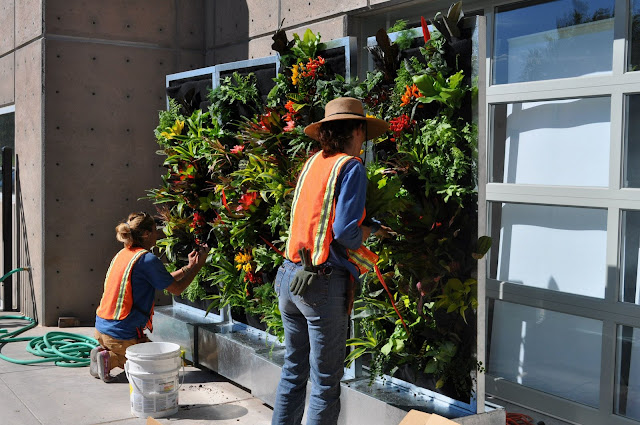
Vertical Gardens: Enhancing Water Conservation Efforts
Introduction
Vertical gardens, also known as green walls or living walls, have gained popularity in recent years due to their numerous environmental benefits. These innovative structures not only enhance the aesthetic appeal of buildings and urban areas but also contribute to water conservation efforts. In this comprehensive article, we will explore the historical background of vertical gardens, define key concepts, and discuss their relevance to water conservation. Furthermore, we will delve into the benefits, techniques, and importance of education for water conservation in vertical gardens. Additionally, we will provide case studies, highlight current trends, address challenges and controversies, and speculate on the future outlook of vertical gardens as a water conservation strategy.
Historical Background
Vertical gardens have a rich historical background, dating back to ancient civilizations such as the Hanging Gardens of Babylon and the terraced gardens of ancient Rome. However, it was not until the 20th century that vertical gardens gained significant attention. The pioneering work of French botanist Patrick Blanc in the late 1980s revolutionized the modern vertical garden design. Blanc’s innovative approach involved using a hydroponic system to grow plants vertically on structures, providing greenery to urban spaces with limited land availability.
Key Concepts and Definitions
Vertical gardens encompass various components such as structures, plant selection, irrigation systems, and water management techniques. These gardens can be implemented using various methods, including modular systems, freestanding structures, or wall-mounted panels. Water conservation refers to the efficient use and preservation of water resources to minimize wastage. In the context of vertical gardens, water conservation entails optimizing irrigation practices, utilizing rainwater harvesting, and selecting appropriate plants that require minimal water.
Main Discussion Points
Point – Benefits of vertical gardens for water conservation
Vertical gardens offer numerous advantages when it comes to water conservation. Firstly, compared to traditional gardens, vertical gardens minimize water usage through their efficient irrigation systems. These systems can deliver water directly to the plants’ root zones, reducing water loss due to evaporation or runoff. Additionally, the vertical structure of these gardens allows for efficient water distribution and retention, preventing water wastage. Furthermore, vertical gardens have the potential for rainwater harvesting, which can significantly reduce the reliance on freshwater sources.
Point – Techniques and strategies for water conservation in vertical gardens
Proper irrigation systems and efficient water management are crucial for water conservation in vertical gardens. Drip irrigation, for instance, delivers water directly to the plants’ roots, minimizing water loss through evaporation. Additionally, the use of recycled or greywater, treated wastewater from sources such as sinks or showers, can be employed for irrigation purposes in vertical gardens. Moreover, selecting drought-tolerant plants and designing the garden layout to optimize shade and moisture retention can further enhance water conservation efforts.
Point – Importance of education and awareness for water conservation in vertical gardens
Education plays a vital role in promoting water-saving practices in vertical gardens. It is essential to educate gardeners and professionals about efficient irrigation techniques, plant selection, and the importance of water conservation. Additionally, community engagement and public awareness campaigns can raise awareness about the benefits and methods of sustainable vertical gardens. By fostering a sense of responsibility towards water conservation, individuals and communities can contribute to the widespread adoption of environmentally-friendly practices.
Case Studies or Examples
Numerous vertical gardens across the globe have successfully implemented water conservation measures. One notable example is the Tree House, a residential building in Singapore, which utilizes a rainwater harvesting system to irrigate the plants, reducing reliance on freshwater sources. Another example is the CaixaForum Madrid, where a stunning vertical garden covers the exterior of the building. This green wall acts as an insulator, reducing the need for air conditioning and minimizing water usage for cooling purposes.
Current Trends or Developments
Recent research has highlighted the effectiveness of vertical gardens in conserving water. Studies have shown that green walls can reduce ambient temperatures, leading to lower water evaporation rates. Furthermore, advancements in vertical garden design, such as the integration of smart irrigation systems and sensor technologies, have enhanced water conservation efforts. These technologies enable precise monitoring and control of water usage, ensuring optimal conditions for plant growth while minimizing wastage.
Challenges or Controversies
Concerns regarding the upfront cost and maintenance requirements of vertical gardens for water conservation have been raised. The initial installation cost of vertical gardens can be higher compared to traditional gardens. However, the long-term benefits, including reduced water consumption and energy savings, often outweigh the initial investment. Additionally, proper maintenance, including regular monitoring of irrigation systems and plant health, is essential to maximize water conservation in vertical gardens.
Future Outlook
The potential growth and adoption of vertical gardens as a water conservation strategy are promising. As more individuals and communities recognize the environmental benefits of these gardens, their popularity is expected to increase. Emerging technologies and techniques, such as the use of fog harvesting and vertical farming, hold promise for further enhancing water conservation in vertical gardens. With continued research and innovation, vertical gardens have the potential to become integral components of sustainable urban landscapes.
Conclusion
Vertical gardens offer an innovative and effective approach to water conservation. By minimizing water usage, optimizing irrigation systems, and raising awareness about sustainable practices, vertical gardens can contribute significantly to global water conservation efforts. As these gardens continue to evolve and adapt to emerging technologies, their role in mitigating the environmental impact of urbanization becomes increasingly vital. With further research, education, and public engagement, vertical gardens have the potential to transform our cities into greener and more sustainable spaces.
References
Blanc, P. (2009). The Vertical Garden: From Nature to the City. W. W. Norton & Company.
Browning, W., Ryan, C., & Clancy, J. (2014). Urban Green: Innovative Parks for Resurgent Cities. Island Press.
Wong, N. H., Tan, A. Y. K., & Tan, P. Y. (2013). Urban Greenery and Sustainable Urban Development: A Review. Resource, Conservation and Recycling, 78, 86-96.